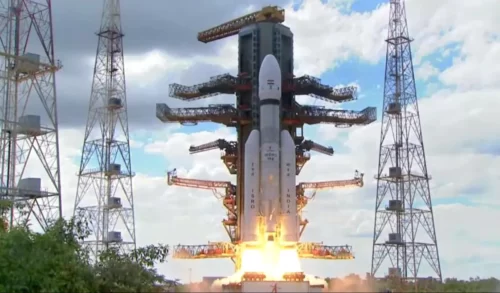Chandrayaan 3: A Mission of Hope and Discovery
- पदसंख्या:
- शेवटची तारीख:
Chandrayaan 3, the ambitious space mission led by the Indian Space Research Organization (ISRO), aims to continue the nation’s pursuit of lunar exploration. Building upon the successes of its predecessors, Chandrayaan 1 and 2, this mission represents a beacon of hope and scientific discovery.

The Importance of Lunar Exploration
Lunar exploration holds immense importance in advancing scientific knowledge and understanding across various fields of study. Here are some key aspects highlighting its significance:
1. Planetary Formation: The Moon is considered a pristine celestial body, preserving records of early solar system processes. By studying lunar samples and conducting observations, scientists can gain insights into the processes that led to the formation and evolution of not only the Moon but also other celestial bodies, including our own planet Earth.
2. Planetary Geology: The Moon’s surface serves as a natural laboratory for studying geology and understanding geological processes. By examining the Moon’s craters, mountains, and volcanic features, scientists can enhance their understanding of impact cratering, volcanism, tectonics, and other geological phenomena. These insights can be applied to the study of Earth and other planets in our solar system.
3. Exoplanet Research: Studying the Moon helps researchers refine their knowledge and techniques for analyzing distant exoplanets. The Moon provides a nearby reference point to understand the behavior of planetary bodies, aiding in the interpretation of data gathered from telescopes observing exoplanets.
4. Lunar Resources: The Moon potentially holds valuable resources, such as water ice and minerals. Understanding the distribution and availability of these resources is essential for planning future human space exploration missions. Lunar resources can provide sustenance, fuel, and building materials, reducing the cost and logistical challenges of deep space missions.
5. Space Weathering and Regolith Processes: The lunar surface is exposed to the harsh space environment, including micrometeorite impacts and solar radiation. By studying the effects of space weathering on the Moon’s surface, scientists can gain insights into similar processes occurring on other airless bodies, including asteroids and Mercury. This knowledge is crucial for understanding the long-term stability and evolution of rocky objects in space.
6. Astrobiology: Lunar exploration contributes to the field of astrobiology, the study of life’s origin, evolution, and potential for existence beyond Earth. By analyzing lunar samples and studying the Moon’s environment, scientists can gain insights into the conditions that support life and investigate the possibility of past or present microbial life on the Moon.
In summary, lunar exploration advances scientific knowledge and understanding by shedding light on planetary formation, geology, exoplanet research, lunar resources, space weathering, and astrobiology. By expanding our understanding of the Moon, we gain valuable insights applicable to a wide range of scientific disciplines, providing a stepping stone for future exploration of the cosmos and deepening our understanding of our place in the universe.
Chandrayaan 3, with its state-of-the-art instruments and advanced technology, is set to contribute significantly to these endeavors.
Chandrayaan program and the significance of Chandrayaan 3
The Chandrayaan program, initiated by the Indian Space Research Organization (ISRO), represents India’s ambitious pursuit of lunar exploration. The program began with Chandrayaan 1, India’s first lunar mission, which was launched on October 22, 2008. Chandrayaan 1 achieved remarkable success by confirming the presence of water molecules on the lunar surface and mapping the Moon’s topography.
Following the success of Chandrayaan 1, ISRO launched Chandrayaan 2 on July 22, 2019. This mission comprised an orbiter, a lander named Vikram, and a rover named Pragyan. However, the lander’s descent did not go as planned, and contact with Vikram was lost during the landing attempt. Despite this setback, the orbiter continued to function, collecting valuable data and capturing images of the lunar surface.
The Chandrayaan program holds immense significance for India and the global scientific community. Firstly, it showcases India’s growing prowess in space exploration and technology. With each mission, India has demonstrated its capability to undertake complex interplanetary missions, placing it among the select few nations with such capabilities.
Moreover, Chandrayaan contributes significantly to our understanding of the Moon and its formation. By studying the lunar surface and its geological features, scientists can gain insights into the early evolution of the Earth-Moon system and the processes that shaped our celestial neighborhood. Additionally, Chandrayaan missions focus on the search for water on the Moon, which is crucial for future human space exploration endeavors. The presence of water would not only provide sustenance for astronauts but also serve as a potential resource for fuel production and habitat construction.
Chandrayaan 3, the next mission in the Chandrayaan program, aims to build upon the achievements of its predecessors. It signifies India’s determination to continue exploring the Moon and expand our scientific understanding. With advanced instruments and technologies, Chandrayaan 3 will delve deeper into the mysteries of the lunar surface, conduct extensive mapping, and investigate the presence of water molecules.
The significance of Chandrayaan 3 lies not only in its scientific objectives but also in the inspiration it provides. The mission inspires young minds to pursue careers in science, technology, engineering, and mathematics (STEM) and fuels the imagination of future generations. It showcases the power of human ingenuity, determination, and collaboration in pushing the boundaries of exploration.
As Chandrayaan 3 takes shape, the world eagerly awaits its launch and the discoveries it will bring. The mission holds the promise of unraveling new insights into the Moon’s geology, origins, and potential resources. It represents India’s commitment to the advancement of scientific knowledge, space exploration, and the exploration of the unknown. Chandrayaan 3 truly embodies a mission of hope, discovery, and the relentless pursuit of human curiosity.
Scientific Objectives of Chandrayaan 3
Chandrayaan 3 is equipped with a suite of scientific instruments designed to explore the lunar surface comprehensively. Its primary objectives include high-resolution imaging, mineral mapping, and detecting the presence of water molecules. By studying the composition and topography of the Moon, Chandrayaan 3 will provide invaluable insights into the Moon’s origin, geological processes, and potential resources.
One of the key objectives of Chandrayaan 3 is to capture high-resolution images of the lunar surface. These images will help scientists analyze the topography and geological features in great detail. By studying the various craters, mountains, and valleys, researchers will gain a deeper understanding of the Moon’s formation and evolution.
Mineral mapping is another crucial objective of the mission. Chandrayaan 3 will employ advanced spectrometers and sensors to identify different minerals present on the lunar surface. This data will aid scientists in studying the Moon’s geology and potentially identifying resources that could be utilized for future lunar exploration missions.
Additionally, Chandrayaan 3 will focus on detecting the presence of water molecules on the Moon. This is of great importance as water is a vital resource for future human missions. By mapping the distribution of water and studying its origin and abundance, scientists can determine the feasibility of utilizing lunar resources for sustenance and fuel.
Chandrayaan 3 Launch Date and Mission Timeline
While the exact launch date of Chandrayaan 3 is yet to be announced, ISRO is meticulously planning the mission to ensure its success. The mission timeline will encompass crucial stages, including the launch, lunar transfer orbit, soft landing, and rover deployment. Stay tuned for updates as India prepares for its next giant leap towards the Moon.

The launch of Chandrayaan 3 will involve a powerful rocket that will propel the spacecraft into space. Once in space, the spacecraft will maneuver into a trajectory that will take it to the Moon. This phase is known as the lunar transfer orbit. It requires precise calculations and adjustments to ensure that the spacecraft reaches the Moon’s vicinity.
Upon reaching the Moon, Chandrayaan 3 will execute a complex sequence of maneuvers to achieve a soft landing on the lunar surface. This is a critical phase of the mission as it requires precise control to ensure a safe touchdown. Once landed, the rover onboard Chandrayaan 3 will be deployed to explore the lunar terrain and collect valuable data.
Challenges and Innovations in Chandrayaan 3
Chandrayaan 3 is not without its challenges. The mission involves complex maneuvers and precise calculations to achieve a soft landing on the lunar surface. However, ISRO’s team of brilliant scientists and engineers have devised innovative solutions to overcome these obstacles. From advanced navigation systems to robust landing technologies, Chandrayaan 3 pushes the boundaries of space exploration.
One of the key challenges in lunar missions is the lunar landing itself. The Moon’s surface is uneven and poses a significant risk to the spacecraft during landing. To overcome this, Chandrayaan 3 will utilize advanced landing technologies, including guidance systems and sensors that will enable the spacecraft to navigate and adjust its trajectory autonomously. These innovations reduce the risks associated with landing on the Moon and increase the chances of a successful mission.
Another challenge is the harsh lunar environment. The Moon experiences extreme temperature variations, radiation, and the absence of an atmosphere. To ensure the survivability of the spacecraft and its instruments, Chandrayaan 3 will be equipped with robust shielding and thermal control systems. These measures will protect the delicate electronics and scientific instruments from the harsh lunar conditions, allowing them to operate optimally and gather valuable data.
Conclusion: The Future of Lunar Exploration
As Chandrayaan 3 embarks on its mission, it represents a significant step towards a future where lunar exploration becomes more accessible and fruitful. The knowledge gained from this mission will not only deepen our understanding of the Moon but also pave the way for further exploration and potential human habitation. Chandrayaan 3 symbolizes India’s commitment to the wonders of space and the limitless possibilities that lie beyond our planet.
With its scientific objectives, innovative technologies, and meticulous planning, Chandrayaan 3 holds the promise of unraveling the secrets of the Moon and shaping the future of space exploration. As we eagerly await the launch and subsequent findings of this remarkable mission, the world watches with anticipation, knowing that every step taken on the lunar surface brings us closer to a greater understanding of our universe and our place within it.
Chandrayaan 3,
Space mission,
Lunar exploration,
Indian Space Research Organization (ISRO),
Moon landing,
chandrayaan 3 kab pahuchega chand pe
![]()
Table of Contents




